Three days after East Hampton Town held its first Eco Fair, the town board reviewed a number of environmental initiatives undertaken by the Natural Resources Department and heard an urgent appeal to seek a grant that would fund a pilot program aimed at restoring Fort Pond in Montauk, which, it was told, “is literally dying.”
Laura Tooman, president of Concerned Citizens of Montauk, told the board at its meeting Tuesday that “significant nutrient inflow issues” were behind the cyanobacteria blooms that have fouled Fort Pond in recent summers. While actions to prevent nitrogen and phosphorus inputs are underway — including the community preservation fund purchase of shoreline properties and the installation of innovative septic systems, as recently happened at the Surf Lodge — a bioextraction effort, akin to an existing project in Accabonac Harbor, Springs, could help, she said.
The pond is dying, Ms. Tooman told the board, “to the point where it is harmful to go near or swim in the water.” She proposed a set of “floating islands,” described as mats to which nutrient-consuming plants are affixed. After a growing season, “You take them out of the system entirely, and you can compost them. It would be nice to get them to the Montauk Community Garden, a nice little circle right in Montauk.”
Last year, the town trustees approved a request from Cornell Cooperative Extension to install 30 metal frames affixed with native algae in Accabonac Harbor, where the trustees have jurisdiction. The purpose was to study the feasibility of removing excess nitrogen by placing and then removing macroalgae that absorb it. “You had tremendous growth” of the macroalgae, an indication of success, Kim Shaw, director of natural resources, said later. C.C.E. officials harvested and analyzed the algae, and will soon present their findings, she said.
As property owner, the town must be a co-applicant for a grant, Ms. Tooman said, and an application must be submitted to Suffolk County by June 18. The town should seek $27,000 for the pilot program, she said. The program would commence next year.
“C.C.O.M. is committed to helping to fund installation and maintenance of these [mats], well into the future,” Ms. Tooman said. The mats, which would be anchored to the bottomland, would be removed after the summer and reused in subsequent years. An educational kiosk to explain the program might be constructed at Kirk Park, at the southern end of the pond, she suggested.
Ms. Tooman’s remarks came in the midst of a Natural Resources Department overview, in which Ms. Shaw outlined a range of remediation projects that are going forward with the help of several grants.
Shoreline stabilization, a bioswale, phragmites removal, and habitat restoration at Pussy’s Pond in Springs have brought a return of menhaden and no algal blooms. “The water quality has improved tremendously,” Ms. Shaw said. Rain gardens are also to be installed there.
The town will use the community preservation fund acquisition of property at 36 Gann Road to showcase environmentally friendly initiatives such as permeable pavement, a bioswale, a septic system upgrade, and native gardens. It is also to house the town’s shellfish hatchery, which is in Montauk at present, and to be used for “green” presentations to the community.
Ms. Shaw described other efforts to “soften” impermeable surfaces, like parking lots, with permeable materials, and discussed the construction of bioswales and rain gardens, and revegetating land to absorb stormwater, in places including Lake Montauk, Accabonac Harbor, and Bay Street in Sag Harbor. Cornell Extension officials, she said, have been helpful in identifying areas of greatest nitrogen flow, to enable the right treatment in the right place.
The department also works to protect endangered shorebirds’ nesting sites, and is working with the vector control division of the County Department of Public Works to monitor marshes in the hope of reducing the application of methoprene, a mosquito larvicide. A pilot program in Accabonac Harbor last year led to a significant reduction in use: The application of methoprene fell by 50 percent and a 195-acre spray area was reduced to 95 acres.
“Kim, you’ve really reinvigorated the Natural Resources Department,” Supervisor Peter Van Scoyoc said at the presentation’s conclusion. “You’ve helped us pursue our water quality improvement goals. . . . You’re at the leading edge of what our efforts are, policy-wise, in the town. You have a great staff, very energetic, full of vigor. Keep up the good work.”

